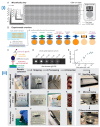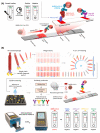Point-of-Care Devices for Viral Detection: COVID-19 Pandemic and Beyond
- PMID: 37763907
- PMCID: PMC10535693
- DOI: 10.3390/mi14091744
Point-of-Care Devices for Viral Detection: COVID-19 Pandemic and Beyond
Abstract
The pandemic of COVID-19 and its widespread transmission have made us realize the importance of early, quick diagnostic tests for facilitating effective cure and management. The primary obstacles encountered were accurately distinguishing COVID-19 from other illnesses including the flu, common cold, etc. While the polymerase chain reaction technique is a robust technique for the determination of SARS-CoV-2 in patients of COVID-19, there arises a high demand for affordable, quick, user-friendly, and precise point-of-care (POC) diagnostic in therapeutic settings. The necessity for available tests with rapid outcomes spurred the advancement of POC tests that are characterized by speed, automation, and high precision and accuracy. Paper-based POC devices have gained increasing interest in recent years because of rapid, low-cost detection without requiring external instruments. At present, microfluidic paper-based analysis devices have garnered public attention and accelerated the development of such POCT for efficient multistep assays. In the current review, our focus will be on the fabrication of detection modules for SARS-CoV-2. Here, we have included a discussion on various strategies for the detection of viral moieties. The compilation of these strategies would offer comprehensive insight into the detection of the causative agent preparedness for future pandemics. We also provide a descriptive outline for paper-based diagnostic platforms, involving the determination mechanisms, as well as a commercial kit for COVID-19 as well as their outlook.
Keywords: COVID-19; POC testing devices; SARS-CoV-2; diagnostics; viral sensor.
Conflict of interest statement
The authors declare no conflict of interest.
Figures










Similar articles
-
Lab-on-a-Disc for Point-of-Care Infection Diagnostics.Acc Chem Res. 2021 Oct 5;54(19):3643-3655. doi: 10.1021/acs.accounts.1c00367. Epub 2021 Sep 13. Acc Chem Res. 2021. PMID: 34516092
-
Emerging point-of-care biosensors for rapid diagnosis of COVID-19: current progress, challenges, and future prospects.Anal Bioanal Chem. 2021 Jul;413(16):4137-4159. doi: 10.1007/s00216-021-03377-6. Epub 2021 May 18. Anal Bioanal Chem. 2021. PMID: 34008124 Free PMC article. Review.
-
Diagnostic assay and technology advancement for detecting SARS-CoV-2 infections causing the COVID-19 pandemic.Anal Bioanal Chem. 2022 Apr;414(9):2903-2934. doi: 10.1007/s00216-022-03918-7. Epub 2022 Feb 25. Anal Bioanal Chem. 2022. PMID: 35211785 Free PMC article. Review.
-
Rapid Quantitative Point-Of-Care Diagnostic Test for Post COVID-19 Vaccination Antibody Monitoring.Microbiol Spectr. 2022 Apr 27;10(2):e0039622. doi: 10.1128/spectrum.00396-22. Epub 2022 Mar 31. Microbiol Spectr. 2022. PMID: 35357223 Free PMC article.
-
Microfluidics-Based Point-of-Care Testing (POCT) Devices in Dealing with Waves of COVID-19 Pandemic: The Emerging Solution.ACS Appl Bio Mater. 2022 May 16;5(5):2046-2068. doi: 10.1021/acsabm.1c01320. Epub 2022 Apr 27. ACS Appl Bio Mater. 2022. PMID: 35473316 Review.
Cited by
-
FlashPCR: Revolutionising qPCR by Accelerating Amplification through Low ∆T Protocols.Int J Mol Sci. 2024 Feb 28;25(5):2773. doi: 10.3390/ijms25052773. Int J Mol Sci. 2024. PMID: 38474020 Free PMC article.
-
A qualitative systematic review of barriers and facilitators to the implementation of community-based molecular diagnostics for infectious diseases.PLoS One. 2025 May 13;20(5):e0321690. doi: 10.1371/journal.pone.0321690. eCollection 2025. PLoS One. 2025. PMID: 40359211 Free PMC article.
-
Recent Advances in Crimean-Congo Hemorrhagic Fever Virus Detection, Treatment, and Vaccination: Overview of Current Status and Challenges.Biol Proced Online. 2024 Jun 26;26(1):20. doi: 10.1186/s12575-024-00244-3. Biol Proced Online. 2024. PMID: 38926669 Free PMC article. Review.
-
Nanomaterial-Based Biosensors for the Detection of COVID-19.Indian J Microbiol. 2025 Mar;65(1):120-136. doi: 10.1007/s12088-024-01336-0. Epub 2024 Jun 23. Indian J Microbiol. 2025. PMID: 40371045
-
Microfluidic Paper-Based Devices.Micromachines (Basel). 2025 Mar 6;16(3):307. doi: 10.3390/mi16030307. Micromachines (Basel). 2025. PMID: 40141918 Free PMC article.
References
-
- Mishra A., Nair N., Yadav A.K., Solanki P., Majeed J., Tripathi V. SARS-CoV-2 Origin and COVID-19 Pandemic Across the Globe. Volume 41 IntechOpen; London, UK: 2021. Coronavirus Disease 2019 (COVID-19): Origin, Impact, and Drug Development.
-
- Verma D., Yadav A.K., Chaudhary N., Mukherjee M.D., Kumar P., Kumar A., Solanki P.R. Recent Advances in Understanding SARS-CoV-2 Infection and Updates on Potential Diagnostic and Therapeutics for COVID-19. Coronaviruses. 2022;3:14–31.
-
- Mofijur M., Fattah I.M.R., Alam M.A., Islam A.B.M.S., Ong H.C., Rahman S.M.A., Najafi G., Ahmed S.F., Uddin M.A., Mahlia T.M.I. Impact of COVID-19 on the social, economic, environmental and energy domains: Lessons learnt from a global pandemic. Sustain. Prod. Consum. 2021;26:343–359. doi: 10.1016/j.spc.2020.10.016. - DOI - PMC - PubMed
Publication types
LinkOut - more resources
Full Text Sources
Miscellaneous

